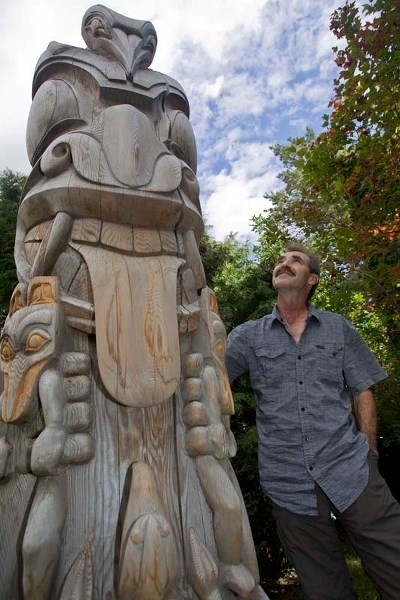Norm Belley doesn't call the eight-foot-tall art he carved and erected in his St. Albert yard a totem pole.
"I don't call it a totem pole because my roots are not Haida or native. I call it a Family Unity Pole, because though I appreciate and honour the Haida Nation's style of art and culture, this is my own," he said.
Like all totems, his art pays tribute to the clan, similar to a coat of arms. The central figure in the carving is a stylized bear and sitting on its head, with its wings wrapped around the bear's ears, there is a raven.
"The centre of the pole is a bear, which represents Norm. His claws are holding two cubs, which are our children. The bear's feet support the pole and I'm the bird sitting on top," said Norm's wife Dorilyn.
Belley, who is a sheet-metal worker by trade, grew up watching his father carve and paint.
"My dad, Hector, loved to paint and his trade was carpentry. He made beautiful things and I grew up carving. I used to whittle little chickens. I still do," Belley explained.
Some years ago, Belley took a wooden-duck-carving course and one teal he entered in a contest earned a second place ribbon. He became entranced with Haida art 30 years ago when he and a friend paddled a canoe through the Broken Group Islands off the west coast of Vancouver Island.
"We talked to people and listened to their stories. We visited museums and art galleries but I couldn't afford the art. So I came home and bought a book," he said.
Masked expression
That same winter, his family decided that any gift given in the annual Christmas gift exchange must be handmade, so Belley started carving.
"I carved a mask," he said, adding that he likes the way he can express his own artistry in masks and totems and that it's different from most decoy carving.
"When you carve a duck it has to be exact. But with the masks or totems, you can be more creative. It's not as structured and it's more my impressions," Belley said.
About 10 years ago a friend presented Belley with the cedar pole, which he had brought from B.C.
"That started it. I had this chunk of cedar and at a certain point I had to start carving it," he said.
The trick was to get each side perfectly symmetrical but Belley solved that by drawing the image on a piece of plastic wrap, which he wrapped around the log once, and then rewrapped again on the other side. All the while, he kept studying the Haida art and symbolism.
Unlike traditional totems, Belley's is smooth and soft to the touch because he has worked the wood and sanded it until it gleams in the late summer light.
Belley claims the pole may never be quite finished. Through the summer he re-carved parts of one of the cubs and there is room on the back for more figures if he wishes to add them. He plans to give the pole a colour wash someday and he may use beeswax to burnish and polish the wood until it has a golden hue.
Belley incorporated many Haida symbols into his Family Unity Pole. The frog at the bottom represents knowledge and power, for example, but the most dominant part of the art is the huge tongue that falls down the centre of the pole. It's hard to believe it is hard cedar wood because it undulates and curves almost as a real tongue might move to whisper a story to the winds.
"The tongue represents that moment of transfer of spirit. It is the moment of transformation from the bear's spirit to a human spirit," Belley said.
Now Belley's transformative totem art rests quietly against a growing cedar tree on the property line he shares with his neighbour. It seems settled somehow, as if it has always been there, although Belley only put it on its stand on July 1. It's unlikely that the cedar will last as long here as it does on the West Coast, but Belley is OK with that.
"It is nature. It was a tree. It is made to go back to the land," he said.




